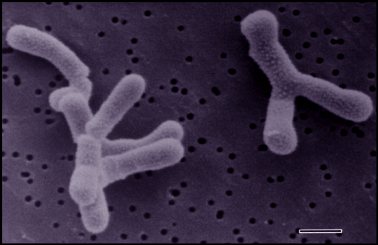Revision as of 19:44, 21 April 2009 by imported>Kelly Smith
All unapproved Citizendium articles may contain errors of fact, bias, grammar etc. A version of an article is unapproved unless it is marked as citable with a dedicated green template at the top of the page, as in this version of the 'Biology' article. Citable articles are intended to be of reasonably high quality. The participants in the Citizendium project make no representations about the reliability of Citizendium articles or, generally, their suitability for any purpose.
 
For the course duration, the article is closed to outside editing. Of course you can always leave comments on the discussion page. The anticipated date of course completion is May 21, 2009. One month after that date at the latest, this notice shall be removed.
Besides, many other Citizendium articles welcome your collaboration!
|
| Bifidobacterium bifidum
|
|
|
| Scientific classification
|
| Domain:
|
Bacteria
|
| Phylum:
|
Actinobacteria
|
| Class:
|
Actinobacteria
|
| Order:
|
Bifidobacteriales
|
| Family:
|
Bifidobacteriaceae
|
| Genus:
|
Bifidobacterium
|
| Species:
|
bifidum
|
|
| Binomial name
|
Bifidobacterium bifidum
|
Bifidobacterium bifidum bacteria [1]

Description and significance
Bifidobacteria are included in a subsection of bacteria known as probiotics. Probiotics are a natural occurrence in the human body, contributing to the beneficial micro flora in the mouth, intestinal tract, as well as vagina. Bifidobacteria help promote digestion, augment the immune system, contribute to the production of lactic and acetic acid, which help control intestinal pH, and in some cases is also associated with a lower incidence of allergies.
Genome structure
Bifidobacterium bifidum has a circular chromosome with a G-C content of approximately 55-67%.
Cell structure and metabolism
Ecology
Pathology
Application to Biotechnology
Current Research
"Effects of galactooligosaccharide and long-chain fructooligosaccharide supplementation during pregnancy on maternal and neonatal microbiota and immunity- a randomized, double-blind, placebo-controlled study."
"Exploring the diversity of the bifidobacterial population in the human intestinal tract."
"Isolation of bifidobacteria from breast milk and assessment of the bifidobacterial population by PCR-denaturing gradient gel electrophoresis and quantitative real-time PCR."
References
[1]↑Martin, R., Jimenez, E., Heilig, H., Fernandez, L., Marin, M.L., Zoetendal, E.G., Rodriguez, J.M. “Isolation of bifidobacteria from breast milk and assessment of the bifidobacterial population by PCR-denaturing gradient gel electrophoresis and quantitative real-time PCR”. Appl Environ Microbiol. February, 2009. Vol. 75, Issue 4. p. 965-9
[2]↑Shadid, R., Haarman, M., Knol, J., Theis, W., Beermann, C., Rjosk-Dendorfer, D., Schendel, D., Koletzko, B., Krauss-Etschmann, S. “Effects of galactooligosaccharide and long-chain fructooligosaccharide supplementation during pregnancy on maternal and neonatal microbiota and immunity-a randomized, double-blind, placebo-controlled study”. Am J Clin Nutr. 2009. Vol. 86. p. 1426-37
[3]↑Turroni, F., Foroni, E., Pizzetti, P., Giubellini, V., Ribbera, A., Merusi, P., Cagnasso, P., Bizzarri, B., de'Angelis, G.L., Shanahan, F., van Sinderen, D., Ventura, M. “Exploring the diversity of the bifidobacterial population in the human intestinal tract”. Appl Environ Microbiol. March, 2009. Vol. 75, Issue 6. p. 1534-45
